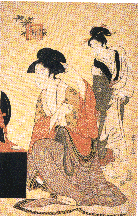
| Eishi |
 |
Nowadays, Utamaro would be the most well-known ukiyoe artist who was active during the kansei era; however, Chobunsai Eishi (1756-1829) was probablly the Utamaro's strongest rival or competitor at that time. Utamaro's works were supported by merchants and craftsmen, whereas Eishi's ukiyoe were supported by people in the samurai class, and that fact would be explained from his background.
Chobunsai Eishi (1756-1829) was from a samurai family, unlike most other ukiyoe artists who were of the merchant class. Eishi was the oldest son of one Tokiyuki, a scion of the House of Hosoda, the Lords of Tanba, one of whom had been Kanjo kata bugyo, or Chancellor of the Exchequer. Eishi used to receive a large amount of government stipend (500 koku), but have this transferred to a deputy in order to concentrate on his ukiyoe work.
It is said that Eishi first learned drawing techniques from Eisenin Michinobu (1730-1790), a painter to the Edo government who was from the Kano-ha (school), and also from Bunryusai (?-?). The techniques from the Kno-ha were especially used for his hand-drawing works . It is believed that he introduced his first ukiyoe in kibyoshi (picture book). Eishi depicts beautiful women and his works had first been influenced by Torii Kiyonaga (1752-1815), Katsukawa Shunsho (?-?), Kitagawa Utamaro , and Kubo Shunman (1757-1820) until around early Kansei era (1789-1801).
He soon began to put his originarity in his works around 1792 or 1793. Eishi mainly depicted full-length human figures in a refined manner. His Ukiyoe women are elegant, and quiet, and like a doll, they look motionless. That is, unlike Utamaro's ukiyoe women, Eishi's women do not show their feelings in their faces. It is said, that was because he was from samurai family and his view of women was strongly influenced by the idea of ideal women among samurai.